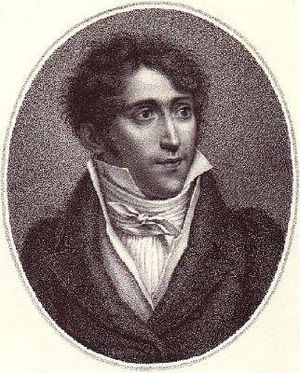Jean Coralli facts for kids
Jean Coralli (born January 15, 1779 – died May 1, 1854) was a French ballet dancer and a person who creates dances (a choreographer). He is most famous for working with Jules Perrot to create Giselle (1841). This ballet is a perfect example of a Romantic ballet from the 1800s.
Early Life and Dance Career
Jean Coralli was born Giovanni Coralli Peracini. His family was from Bologna, Italy, but they lived in Paris, France. His father was an actor at a theater called the Théâtre Italien.
As a child, Jean studied at the ballet school of the Paris Opera. But he decided to start his career as a dancer and choreographer in Vienna, Austria. For a short time in 1802, he danced at the Paris Opera and then at the King's Theatre in London. After that, he went back to Vienna to become the ballet master (the main person in charge of ballet) at the Hoftheater.
In these early years, Jean and his wife, Teresa Coralli, became a very famous dancing couple. They were often shown in pictures from that time. They danced the main roles in most of the ballets Jean created at the Hoftheater, like Helena und Paris (1807). Starting in 1809, the Corallis were lead dancers at important theaters in Milan, Venice, and Lisbon.
From 1825 to 1829, Coralli worked as the ballet master at the Théâtre de la Porte Saint-Martin in Paris. There, he created ten full-length ballets and many short dance pieces for plays. His dance company included talented dancers like Charles-François Mazurier, a well-known comic dancer. It also included Jules Perrot (1810-1892) and Joseph Mazilier (1801-1868), who both became famous choreographers later on.
The Porte Saint-Martin theater was known for its exciting Romantic plays and new ballets. Many of these ballets were similar to what would later be shown at the Paris Opera. For a play in 1828, Coralli created a dance called a pas de sylphides. This dance hinted at the magical, supernatural white ballets that became popular years later.
Working at the Paris Opera
In 1831, Coralli became the main ballet master of the Paris Opera. He took over from Jean-Louis Aumer. His first work there was a new version of his 1828 ballet Léocadie. It had a new story, new music, and a new name, L'Orgie (1831).
His next big project was the ballet for the opera La Tentation (1852). This ballet used the growing popularity of stories, ballets, and operas that featured magic and supernatural elements. It was the first of many works he created for the opera stage.
After that came a major dance work called La Tempête, ou L'Ìle des Génies (The Tempest, or The Isle of Magic Spirits, 1834). The music for this ballet was by Jean Schneitzhoeffer. Pauline Duvernay and Joseph Mazilier danced the main roles of Léa and Fernando. The young dancer Fanny Elssler, who was just starting to become famous, played the fairy Alcine. Elssler became a true star in Coralli's next work, Le Diable Boiteau (The Lame Devil, 1836). In this ballet, she performed "La Cachucha," a Spanish dance that she might have even created herself!
The most important moment in Coralli's career was in 1841. That's when the ballet Giselle, ou Les Wilis was first performed at the Paris Opera. The story was written by Théophile Gautier and Jules-Henri Vernoy de Saint-Georges. The music was by Adolphe Adam. Jules Perrot had told Coralli about the music because he wanted to find a great role for his student, Carlotta Grisi.
At the first show, Grisi danced with Lucien Petipa. He played Albrecht, a prince whose actions lead Giselle to sadness and death. The "peasant pas de deux" (a dance for two) in the first act was performed by Nathalie Fitzjames and Auguste Mabille. This part had extra music by Friedrich Burgmüller. Adèle Dumilâtre danced the challenging role of Myrtha, the queen of the wilis. The wilis were angry spirits of young women who had been tricked by their lovers.
Gautier and the composer Burgmüller worked with Coralli again on his next ballet, La Péri (1843). This was a complex story about an Eastern fairy who was loved by a young man. With Grisi and Petipa as the main dancers, Coralli's choreography (the dance steps he created) was praised by both the newspapers and the public. The ballet was a big success.
His second-to-last ballet, Eucharis (1844), was not successful. His very last ballet, Ozaï (1847), was only performed ten times. Coralli retired from his job at the Paris Opera in 1854. He passed away just four years later.
Selected Works
Here are some of Coralli's most important ballets:
- 1806: Paul et Rosette
- 1806: Amphion
- 1807: Les Incas
- 1807: Hélène et Pâris
- 1815: La Dansomanie
- 1816: Les Noces de Zéphire et Flore
- 1825: La Statue de Vénus
- 1825: Les Ruses Espagnoles
- 1826: Monsieur de Pourceaugnac
- 1826: Gulliver
- 1826: La Visite à Bedlam
- 1827: Le Mariage de Raison
- 1827: La Neige
- 1828: Les Hussards et les Jeunes Filles
- 1828: Léocadie
- 1829: Les Artistes
- 1830: La Somnambule
- 1830: Le Mariage de Raison
- 1831: L'Orgie
- 1832: La Tentation
- 1834: La Tempête, ou L'Île des Génies
- 1836: Le Diable Boiteux
- 1837: La Chatte Métamorphosée en Femme
- 1839: La Tarentule
- 1841: Giselle, ou Les Wilis, with Jules Perrot
- 1843: La Péri
- 1844: Eucharis
- 1847: Ozaï
See also
 In Spanish: Jean Coralli para niños
In Spanish: Jean Coralli para niños
- List of dancers



